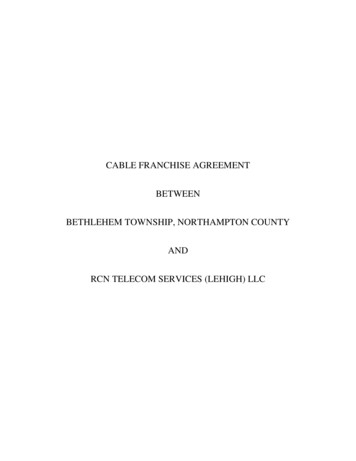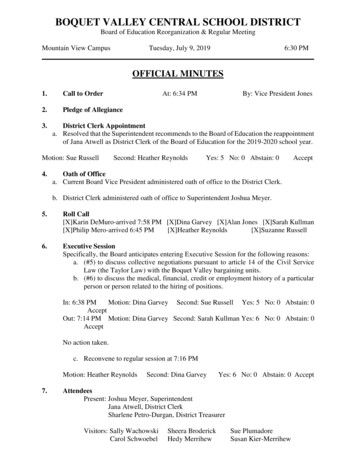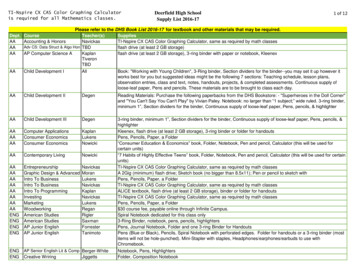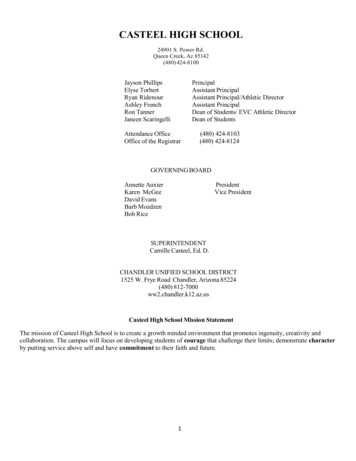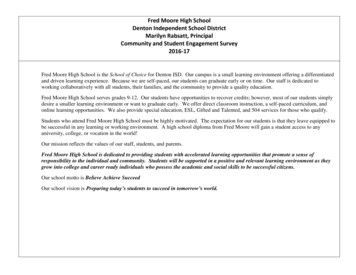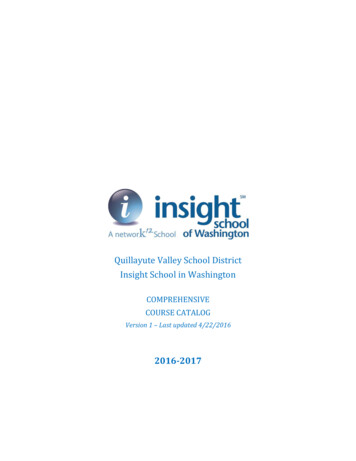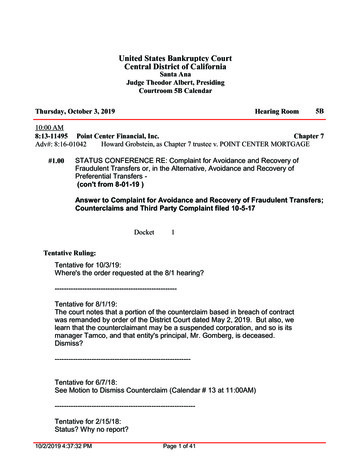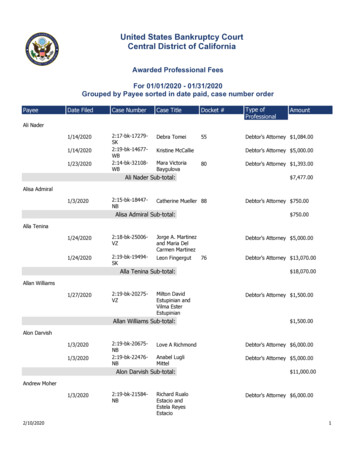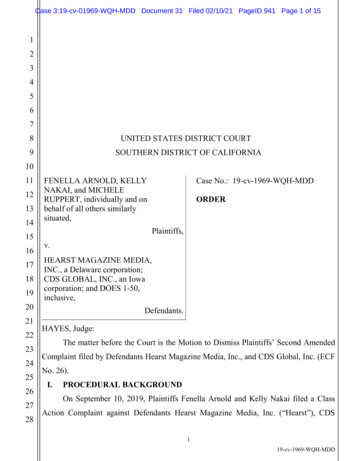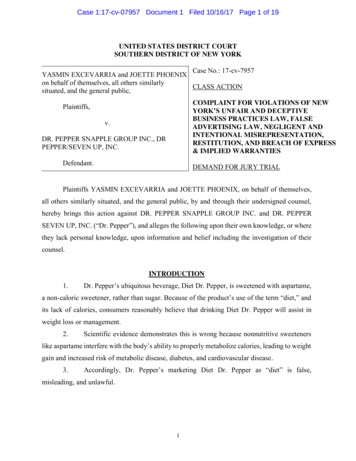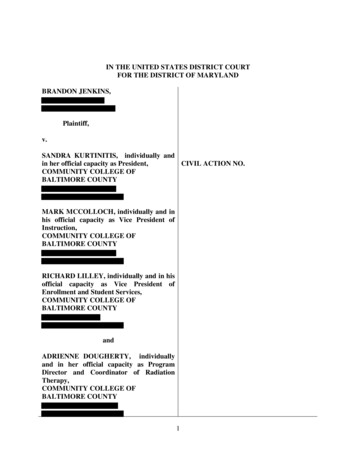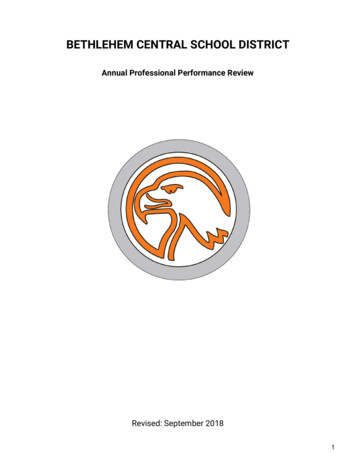
Transcription
BETHLEHEM CENTRAL SCHOOL DISTRICTAnnual Professional Performance ReviewRevised: September 20181
TABLE OF CONTENTSIntroduction . . . . . . . . . . . . . . . . . . . . . . . . . . . . . . . . . . . . . . . . . . . . . . . . . . . . . . . . . . . . . . . . . . . . . . . . . . . 3Part I :Definitions . . . . . . . . . . . . . . . . . . . . . . . . . . . . . . . . . . . . . . . . . . . . . . . . . . . . . . . . . . . . . . . . . . . .4Part II :Training of Evaluators . . . . . . . . . . . . . . . . . . . . . . . . . . . . . . . . . . . . . . . . . . . . . . . . . . . . . . . . . . .6Part III:Data Management . . . . . . . . . . . . . . . . . . . . . . . . . . . . . . . . . . . . . . . . . . . . . . . . . . . . . . . . . . . . . 8Part IV :Teacher Appraisal Process . . . . . . . . . . . . . . . . . . . . . . . . . . . . . . . . . . . . . . . . . . . . . . . . . . . . . 10Part V :Supervisor Appraisal Process . . . . . . . . . . . . . . . . . . . . . . . . . . . . . . . . . . . . . . . . . . . . . . . . . . . 18Part IV :Improvement Plans . . . . . . . . . . . . . . . . . . . . . . . . . . . . . . . . . . . . . . . . . . . . . . . . . . . . . . . . . . . 20Teacher Improvement Plan (“TIP”)Supervisor Improvement Plan (“SIP”)Part VII : Appeals . . . . . . . . . . . . . . . . . . . . . . . . . . . . . . . . . . . . . . . . . . . . . . . . . . . . . . . . . . . . . . . . . . . . . 21Part VIII: Miscellaneous . . . . . . . . . . . . . . . . . . . . . . . . . . . . . . . . . . . . . . . . . . . . . . . . . . . . . . . . . . . . . . . 24Required CertificatesFiling and Publication of APPR PlanMonitoringPart IX:Appendix . . . . . . . . . . . . . . . . . . . . . . . . . . . . . . . . . . . . . . . . . . . . . . . . . . . . . . . . . . . . . . . . . . . . 25-2-
INTRODUCTIONAnnual Professional Performance Review (“APPR”) supports the professional growth of oureducators. A successful review system should provide timely feedback, an opportunity toacknowledge educators’ strengths as well as their weakness and an opportunity for growth as aneducator.This APPR system will be a significant factor in all employment decisions including but not limited to: Retention Tenure Determination Termination Level of Teacher PerformanceThe District’s Professional Practices Council will work with all available resources to assist indesigning, implementing, monitoring and recommending adjustments to the APPR. Any changes tothe plan must go through collective negotiations.-3-
PART IDefinitionsApproved Teacher or Principal Practice Rubric : Rubric approved by the Commissioner of Educationfor inclusion on SED’s list of approved rubrics for teacher or principal evaluations.Approved State Assessment : Assessments approved by the Commissioner of Education for inclusionon SED’s list of approved assessments for use within the Student Performance Category.Building Principal or Principal : Principal, co-principal or administrator in charge of an instructionalprogram of a district or BOCES.Classroom Teacher or Teacher : Teacher in the classroom teaching service as defined by section80-1.1 of the Commissioner’s regulations who is the teacher of record, except evening schoolteachers of adults enrolled in nonacademic, vocational subjects, and supplemental school personnelincluding teacher aides and teaching assistants.Common Branch Subject : Any or all of the subjects usually included in the daily program of anelementary school classroom such as arithmetic, civics, visual arts, elementary science, Englishlanguage, geography, history, hygiene, physical activities, practical arts, reading, music, writing, andsuch other similar subjects.Co-Principal : Certified administrator designated to have executive authority, management, andinstructional leadership responsibility for all or a portion of school or BOCES-operated instructionalprogram, where more than one such administrator is so designated. The term implies equal lineauthority with each reporting to a district-level or comparable BOCES-level supervisor.Independent Evaluator : Individual who conducts an evaluation of a teacher who is not the teacher’sprimary supervisor or administrator.Lead Evaluator : Primary individual responsible for conducting and completing an evaluation underthis APPR plan.Leadership Standards: The Educational Leadership Policy Standards: ISLLC 2008 as adopted by theNational Policy Board for Educational Administration.Scoring Matrix: The New York State HEDI scale that will be used to determine the teacher’s overallrating.Student Growth : Change in individual student achievement between two or more points in time.-4-
Student Growth Percentile Score : Result of a statistical model that calculates each student’s changein achievement between two or more points in time on a State assessment or other comparablemeasure and compares each student’s performance to that of similarly achieving students.Subcomponents : The two subcomponents of a teacher’s evaluation are the teacher observationcategory and the student performance category. These categories will be used to determine theteachers overall rating using the scoring matrix.Teacher of Record : As defined by the Commissioner.Value Added Growth Score : Result of a statistical model that incorporates a student’s academichistory and may use other student demographics and characteristics, school characteristics and/orteacher characteristics to isolate statistically the effect on student growth from those characteristicsthat are generally not in the teacher’s or supervisor’s control. The characteristics may be different forteachers and supervisors.-5-
PART IITraining of EvaluatorsThe District will ensure that all Lead Evaluators/Independent Evaluators are properly trained andcertified to complete an individual’s performance review. Evaluator training will be conducted byappropriately qualified individuals or entities. Evaluator training will replicate the recommended SEDmodel certification process.The District will ensure that all evaluators are trained as lead evaluators. The superintendent willcertify lead evaluators upon receipt of proper documentation that the individual has fully completedtraining. The superintendent will maintain records of certification of evaluators.Evaluator training will occur regionally in cooperation with BOCES. Training will be conducted byCapital Region BOCES Network Team personnel who have participated in the NYSED evaluatortraining for Network Teams and/or personnel authorized to train on behalf of an evaluation rubricapproved by NYSED. Evaluators will be recertified on a yearly basis.The District will establish a process to maintain inter-rater reliability over time in accordance withNYSED guidance and protocols recommended in training for lead evaluators. These protocols willinclude measures such as data analysis; periodic comparisons of assessments; and/or annualcalibration sessions across evaluators. This training will include the following Requirements for Lead Evaluators/IndependentEvaluators: New York State Teaching Standards and ISLLC Standards Evidence-based observation Application and use of Student Growth Percentile and Value Added Growth Model data Application and use of the State-approved teacher or principal rubrics Application and use of any assessment tools used to evaluate teachers and principals Use of Statewide Instructional Reporting System (SIRS) Scoring methodology used to evaluate teachers and supervisors Specific considerations in evaluating teachers and supervisors of ELL’s and students withdisabilities.Chief Lead EvaluatorThe Assistant Superintendent for Educational Programs, building principals and supervisors will betrained and certified as a lead evaluator according to SED’s model to ensure consistency anddefensibility.-6-
ResponsibilitiesThe Chief Lead Evaluator and/or designee(s) will train and certify each principal, assistant principal,hall principal, and supervisor in the District based on the same model. All trained evaluators may doobservations, but are prohibited from summative evaluations until they are appropriately certified.TimingAll lead evaluators and principals shall be appropriately trained and certified by September 1 st of eachschool year or thirty (30) days after appointment.Re-Certification and Updated TrainingThe District will work to ensure that lead evaluators maintain inter-rater reliability over time and thatthey are re-certified on an annual basis and receive updated training on any changes in the law,regulations or applicable collective bargaining agreements.-7-
PART IIIData ManagementThe District will work with State Education Department (the “SED”) to develop a process that aligns itsdata systems to ensure that SED receives timely and accurate teacher, course and student “linkage”data, as well as a process for teacher and principal verification of the courses and/or student rostersassigned to them.Ensuring Accurate Teacher and Student DataThe District shall ensure that SED receives accurate teacher and student data, including enrollmentand attendance data and any other student, teacher, school, course and teacher/student linkage datanecessary to comply with the Regulations of the Board of Regents and Commissioner of Education byproviding such data in a format and timeline prescribed by the Commissioner.The District’s student data system records teacher assignments, student enrollment, and studentattendance. The District will verify assignments of classroom teachers of common branch subjects,ELA and Mathematics Grades 4-8 (described below). The NYSED APPR Guidance provides thefollowing guidance when reporting data for the school year relating to Teacher of Record:The District collects data on student enrollment, attendance, and achievement on statewideassessments through our student management system. This information is periodically reviewedand corrected by district support staff and administration. Prior to submission to the DataWarehouse, the data is extracted from our student management system and formatted in accordancewith the specifications provided by NERIC.The New York State Education Department’s APPR Guidance and field memos relating to the StudentInformation Repository System (SIRS) will provide detailed guidance related to the collection andreporting of data, including student-teacher linkage and student attendance. The District will continueto monitor data and develop additional processes, as needed and consistent with NYSED reportingrequirements, to verify that the data submitted to the State are complete and accurate. The NYSEDadvises that it will provide roster verification reports to assist in this process (see APPR Guidance,L4 ). The NYSED also will provide guidelines for the use of student-teacher instructional weightingand student exclusion flags (see A PPR Guidance, L8 ).Verification: The District’s student data system identifies teacher assignments and studentenrollment and attendance. The District has obtained the NYSED statewide unique identifier forcertain certified individual employed by the District through “TEACH” this information has or will beentered into the District’s data system and will be extracted from the District’s system and reported toSIRS in accordance with NYSED guidance. The District will verify assignments of all teachers. Eachprincipal is responsible for creating student assignments and entering the class rosters into ourstudent management system. The principals review this information in August and notify teachers of-8-
the students assigned to them for the year. Any students who enroll after the school year begins areentered into our student management system and the teacher is notified of the additional studentassigned to them.Reporting Individual Subcomponent Scores: The District will report to NYSED the overall rating foreach classroom teacher and building principal in the District in a format and timeline prescribed bythe Commissioner. The District will develop a process for timely and accurate extraction of such dataand will use SIRS data reporting extracts protocols for reporting these data to NYSED. TotalComposite Effectiveness Scores will not be reported until data on student achievement on stateassessments is transmitted to the District.Development, Security and Scoring of Assessments: The District shall ensure the development,security and scoring processes of all assessments and/or measures used to evaluate teachers andsupervisors under this section are not disseminated to students before administration and thatteachers and principals do not have a vested interest in the outcome of the assessments they score. Development: The District will work with the PPC committee and the teachers’ association todetermine decisions about measures of student performance, the teacher/supervisorobservation rubrics; and the scoring methodology for the student performance andteacher/supervisor observation categories. Security: The District will follow the testing guidelines set forth by NYSED in regards tosecuring any NYS exams. Scoring: The District will ensure that all assessments are scored in the manner as prescribedby the assessment.-9-
PART IVTeacher Appraisal ProcessOur BeliefIt is our belief that the teacher appraisal process is a partnership among teachers, supervisors, andadministrators to promote professional growth. This partnership represents a professionalcommunity and our plan for growth and evaluation presumes that teachers are competent and thattheir performance is at the effective level. It also presumes that it is every teacher’s responsibility tocontinue to grow professionally. This partnership is based on mutual understanding, respect, andhonest communication. It is with this understanding that we work to provide quality instruction forour students in a learning climate where everyone has the opportunity to reach their highest potential.Tenured/Part-Time Teacher Evaluation ProcessEvery tenured/part-time teacher will be formally observed minimally three times during the year. Oneobservation will be a full class period and will include a pre-conference and post-conference with theLead Evaluator. During the pre-conference, the teacher is expected to provide a written lesson planand to review the anticipated lesson with the Lead Evaluator. Within 10 school days of the formalobservation, a post-conference will take place. This will allow for a professional dialogue to takeplace between the Lead Evaluator to review the lesson and address commendations andrecommendations for the future. At the post-conference, the Lead Evaluator will also indicate thecomponents of the 2011 Frameworks for Teaching Rubric which were evaluated during this process.There will be two other formal classroom observations that may be of a shorter duration; one ofwhich will be unannounced. At least one of these observations must be performed by anIndependent Evaluator. After these observations, the evaluator will, within 10 school days, completeany observed components of the rubric and will inform the teacher that they have addedcomments/feedback to the 2011 Frameworks for Teaching Rubric. The teacher will then be able toview the additions that were added.At a mid-year conference, the Lead Evaluator will discuss the performance of the teacher based onobservations up to that point in the year. Prior to June 20, an end of year meeting will take place withthe teacher and the Lead Evaluator to discuss the Teacher Observation Category. The StudentPerformance Category will be reviewed with the teacher as soon as the rating becomes available.Once the teachers overall rating is complete and available, the Lead Evaluator will meet with theteacher to review their performance and the Scoring Matrix. At this meeting, all documents will besigned by the teacher and Lead Evaluator. It is the responsibility of the Lead Evaluator to scheduleand meet with the teacher by September 30 of the following school year. The original copy will befiled with the Assistant Superintendent and copies will be provided to the teacher. If the overall ratingplaces the teacher in the developing or ineffective category, a teacher improvement plan will beinitiated.- 10 -
Probationary/Replacement Evaluation ProcessEvery probationary/full-time replacement teacher will be formally observed minimally four timesduring the year. At least one of the formal observations must be performed by an IndependentEvaluator. Formal observations will be a full class period and will include a pre-conference andpost-conference with the evaluator. One of the formal observations will be unannounced and will onlyinclude a post-conference. During the pre-conference, the teacher is expected to provide a writtenlesson plan and to review the anticipated lesson with the evaluator. Within 10 school days of theformal observation, a post-conference will take place. This will allow for a professional dialogue totake place between the evaluator to review the lesson and address commendations andrecommendations for the future. At the post-conference, the Lead Evaluator will also indicate thecomponents of the 2011 Frameworks for Teaching Rubric which were evaluated during this process.At a mid-year conference, the Lead Evaluator will discuss the performance of the teacher based onobservations up to that point in the year. Prior to June 20, an end of year meeting will take place withthe teacher and the Lead Evaluator to discuss the Teacher Observation Category. The StudentPerformance Category will be reviewed with the teacher as soon as the rating becomes available.Once the teachers overall rating is complete and available, the Lead Evaluator will meet with theteacher to review their performance and the Scoring Matrix. At this meeting, all documents will besigned by the teacher and Lead Evaluator. It is the responsibility of the Lead Evaluator to scheduleand meet with the teacher by September 30 of the following school year. The original copy will befiled with the Assistant Superintendent and copies will be provided to the teacher. If the overall ratingplaces the teacher in the developing or ineffective category, a teacher improvement plan will beinitiated.Sub-Components of APPR Process for All TeachersAll Classroom TeachersEach teacher reviewed pursuant to this Part will receive a rating based on Student PerformanceCategory and the Teacher Observation Category, which shall be used on the Scoring Matrix todetermine the overall rating of (1) Highly Effective, (2) Effective, (3) Developing, (4) Ineffective.Annual Professional Performance Sub-Components1. Student Performance Category:a. Grades 4-8 ELA and Math classroom teachers shall have a student performance ratingdetermined by NYSED.b. Grade 3 ELA and Math teachers, grade 8 science teachers, high school English, math, science,and social studies teachers whose course is associated with a state assessment must usethat assessment in determining the student performance rating. This rating will be calculatedand provided by the district. (See Appendix C)- 11 -
c. All other classroom teachers: The five required Regents Examinations (Common Core English,Common Core Algebra I, Living Environment, Global 2, and US History) will be used todetermine the student performance rating. This rating will be calculated provided by thedistrict. (See Appendix C)Bethlehem Central School DistrictStudent Performance CategoryScore and RatingMinimum ScoreMaximum ScoreH (Highly Effective)1820E (Effective)1517D (Developing)1314I (Ineffective)0122. Teacher Observation Category:a. The District shall assign appropriately trained evaluators to perform 3 classroom observationsfor tenured/part-time/less than full year replacement teachers; one of which will beunannounced and 4 classroom observations for probationary/full year replacement teachers;one of which will be unannounced. These observations will be performed
Warehouse, the data is extracted from our student management system and formatted in accordance with the specifications provided by NERIC. The New York State Education Department’s
